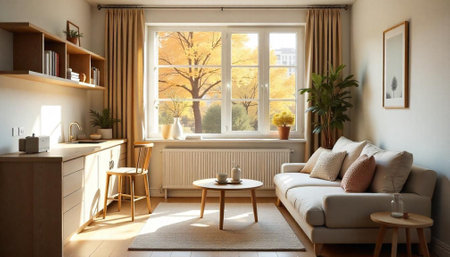Introduction to Stained and Leaded Glass in the UK
Stained and leaded glass windows are an iconic feature of British architecture, admired for their artistry and practical benefits alike. From the soaring cathedrals of medieval England to the inviting bay windows of Victorian terraced homes, these decorative elements have played a significant role in shaping the nation’s architectural identity. Historically, stained glass was used not only to bring colour and light into sacred spaces but also to tell stories—biblical scenes, heraldic emblems, or local legends—etched into every pane. In more recent centuries, leaded glass became a hallmark of domestic elegance, gracing period properties with intricate patterns and lending character to otherwise modest facades. The enduring presence of stained and leaded glass throughout the UK speaks to its deep cultural significance, blending beauty with functionality in a uniquely British tradition.
2. Aesthetic Appeal and Artistic Value
Stained glass and leaded windows have long been cherished in British architecture for their ability to transform both period properties and contemporary homes. Their decorative function is not merely visual; it is an interplay of colour, texture, and light that can completely alter the ambience of a space. Whether found in historic churches, Victorian terraces, or modern renovations, these windows act as focal points, reflecting Britain’s rich cultural heritage while serving present-day aesthetic demands.
The Decorative Impact
One of the most striking features of stained and leaded glass is their capacity to enhance natural daylight. When sunlight passes through the coloured panes, it casts vibrant patterns across floors and walls, creating a living artwork that evolves throughout the day. This dynamic quality brings warmth and character to interiors—something plain glazing cannot replicate.
Enhancing Character: Interior vs Exterior
| Interior Impact | Exterior Impact | |
|---|---|---|
| Visual Interest | Adds depth and focal points to rooms | Curb appeal with distinctive facade features |
| Atmosphere | Softens harsh light, creates mood | Reflects architectural style and era |
| Personalisation | Bespoke designs tell stories or mark heritage | Sets property apart from neighbouring buildings |
Blending Artistry with Practicality
The artistry involved in stained and leaded glass production is significant—skilled craftsmen select coloured glass, cut intricate shapes, and carefully assemble them using traditional lead cames. These techniques ensure each window is unique, often becoming a lasting family or community legacy. At the same time, these windows must be designed to withstand the UK’s variable climate, ensuring they remain beautiful and functional for decades.
![]()
3. Traditional Techniques and Materials Used
Stained glass and leaded windows have long held a special place in British architecture, celebrated for their artistic and practical qualities. The traditional craftsmanship behind these windows is rooted in centuries-old techniques that are still honoured today by skilled artisans across the UK. At the heart of this craft is the careful selection and cutting of coloured glass, each piece chosen for its hue and clarity to create intricate patterns or vivid pictorial scenes.
The types of glass commonly used in British stained glasswork include antique glass, cathedral glass, and opalescent glass. Antique glass is prized for its unique textures and subtle colour variations, often achieved through mouth-blowing methods. Cathedral glass offers a more uniform appearance with vibrant colours, while opalescent glass introduces milky, swirling effects that add depth to any design. Each type contributes its own character, allowing artists to tailor windows to both historic and modern settings.
Central to the construction process is the use of lead came – slender strips of lead shaped into an H-profile, which hold the individual pieces of glass together. This technique not only provides structural integrity but also creates the signature lines seen in stained glass artwork. Craftspeople carefully solder joints at intersections and apply waterproofing compounds to ensure durability against Britain’s famously variable weather. These time-honoured methods, combined with high-quality materials, result in windows that are as robust as they are beautiful, embodying a legacy of British ingenuity and attention to detail.
4. Practical Benefits Beyond Beauty
While stained glass and leaded windows are often celebrated for their striking aesthetics, their practical advantages should not be overlooked. These traditional features offer a host of benefits that enhance the comfort, efficiency, and security of British homes and heritage properties.
Thermal Insulation
Modern adaptations of stained glass and leaded windows can significantly improve a building’s thermal performance. By employing double glazing or secondary glazing techniques, homeowners can maintain the charm of original designs while reducing heat loss. This is particularly valuable in the UK climate, where retaining warmth during colder months is essential for energy efficiency and comfort.
Acoustic Benefits
Leaded and stained glass windows provide superior sound insulation compared to standard single-pane glazing. The combination of thicker glass, multiple panes, and the use of lead cames helps to dampen external noise—making them ideal for properties located near busy roads or urban environments.
Enhanced Security
The robust construction of leaded windows inherently adds an extra layer of security to a property. The small individual panes set within sturdy lead strips are more difficult to break through than larger sheets of glass. Additionally, advancements such as laminated or toughened glass can be incorporated without compromising the traditional appearance.
Sustainability Contributions
In terms of sustainability, restoring and maintaining original stained glass reduces the need for manufacturing new materials, thereby lowering environmental impact. Many specialist glaziers now source sustainable materials and use eco-friendly methods for repairs and replacements, helping period homes meet modern green standards.
Summary Table: Practical Benefits
| Benefit | Description | Typical Application in the UK |
|---|---|---|
| Thermal Insulation | Reduces heat loss, improves energy efficiency | Double/secondary glazed stained glass in period homes |
| Acoustic Insulation | Dampens street and environmental noise | Urban terraced houses & listed buildings |
| Security Enhancement | Makes break-ins more difficult due to smaller panes and strong leads | Victorian & Edwardian properties with original windows |
| Sustainability | Minimises waste by restoring existing materials; uses eco-friendly practices | Heritage restoration projects across the UK |
The enduring appeal of stained glass and leaded windows goes well beyond their decorative qualities. They remain a sensible choice for homeowners seeking both characterful design and tangible improvements in property performance.
5. Maintenance, Repairs, and Preservation Advice
Routine Care for Stained Glass and Leaded Windows
Regular maintenance is key to preserving the charm and structural integrity of stained glass and leaded windows commonly found in British homes and historic buildings. Begin by gently dusting the glass with a soft, dry cloth or a natural-bristle brush to remove loose dirt. For more thorough cleaning, use a mild, pH-neutral soap diluted in water and wipe carefully with a lint-free cloth—never use abrasive cleaners or tools, as these can scratch both the glass and lead cames. It’s best to check for any signs of condensation or moisture build-up around the frame, as prolonged dampness can damage both woodwork and metalwork.
Identifying Common Issues: Weathering and Bulging
Given the UK’s often unpredictable weather, stained glass windows are susceptible to specific issues such as weathering, corrosion of lead cames, bulging panels, or loose putty. Over time, wind and rain can cause the lead framework to weaken, resulting in slight warping or bulging of the panes. Discolouration or a white powdery residue on the lead may indicate oxidation, while crumbling putty could allow water ingress. It’s advisable to inspect your windows at least annually for these warning signs—especially after severe weather events.
When to Call in a Specialist
While basic cleaning and light maintenance can be managed by most homeowners, certain repairs require specialist intervention. If you notice broken panes, significant bulging, cracked solder joints, or failing structural support bars (known locally as saddle bars), it’s time to consult an accredited conservator with experience in stained glass restoration. Attempting complex repairs yourself may exacerbate damage or reduce the historical value of period features. In the UK, many local councils and heritage organisations can recommend trusted professionals who adhere to best practices for sensitive restoration projects.
Preservation Tips for Lasting Beauty
To ensure your stained glass remains a stunning feature for generations, consider installing protective secondary glazing—especially in listed properties where external alterations are restricted. Keep all drainage channels clear to prevent water pooling at the base of frames. Lastly, document any changes or repairs made over time; this record will be invaluable for future conservation efforts.
Conclusion: Striking the Balance Between Beauty and Practicality
Stained glass and leaded windows are not only decorative treasures but also intricate assemblies demanding thoughtful care. By combining regular upkeep with timely professional attention when needed, you’ll safeguard both their aesthetic appeal and functional strength within Britain’s unique architectural landscape.
6. Modern Use and Adaptation in Contemporary Homes
Today, stained glass and leaded windows are enjoying a resurgence in British homes, blending timeless beauty with modern practicality. Homeowners and architects across the UK are finding innovative ways to incorporate bespoke stained or leaded glass into new builds and renovations alike. This revival not only honours traditional craftsmanship but also meets contemporary standards for energy efficiency and security.
Embracing Classic Aesthetics
In many new developments, stained and leaded glass is used as a focal point for entryways, stairwells, or feature windows. These installations often draw inspiration from classic Victorian or Edwardian patterns, but are tailored to suit the architectural lines of modern properties. For instance, homeowners may commission custom panels that echo period motifs yet use clear or lightly tinted glass to maintain bright, open interiors.
Integrating with Modern Technology
Modern glazing techniques allow these decorative features to be double- or triple-glazed, significantly improving thermal performance without compromising on visual appeal. This ensures that even in the most energy-conscious homes, the charm of stained or leaded glass can be enjoyed without draughts or heat loss—a key consideration in today’s eco-friendly builds.
Examples Across the UK
From converted London townhouses to countryside barn conversions in Yorkshire, examples abound of clients opting for bespoke stained glass panels. Some choose to restore original features during renovation; others commission entirely new designs that reflect personal heritage or local landscapes. For example, a new build in Surrey might feature a contemporary geometric leaded design inspired by local woodland, while a Glasgow flat conversion could revitalise original stained glass transoms as a nod to its historic character.
This blending of old and new demonstrates the enduring appeal of stained and leaded glass in British architecture—offering homeowners a way to celebrate tradition while embracing the comforts and efficiencies of modern living.


